Sunday, March 31, 2019
“Shoplifters”: When Love Lives Amidst Ethical and Moral Violation
from The New Social Worker Online — the professional social work careers magazine https://ift.tt/2CML7eR
Introduction to Encrusting Corals of the Indo-Pacific
In an ongoing series identifying Indo-Pacific coral species and growth forms, we’ve covered types including branching and plating. Today we’ll take a look at encrusting corals of the Indo-Pacific.
Corals are living animals seeking out life on the reef. Each coral is made from tiny animals called polyps, which build a hard calcium-carbonate shell around their body for protection. These hard skeletons grow together to become the coral reef. You will notice while diving, snorkeling, or just looking at pictures of a reef, that there are many different shapes, sizes, and forms.
If you’re new to coral identification in general, look at our “Coral Biology: Part I” and “Coral Biology: Part II” articles. These will help you learn the basics of coral biology, as well as some helpful terms for identification. And if you’re new to Indo-Pacific coral identification, check out our “Introduction to Hard Corals of the Indo-Pacific.”
Encrusting corals of the Indo-Pacific
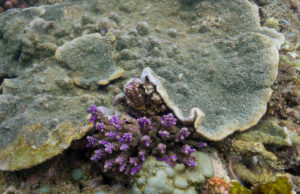
Encrusting corals can overtake other corals, forming plates or shelves above the substrate. We would still call this an encrusting species.
The corals that divers most easily overlook are the encrusting species. These corals creep along the rocks, holding everything together like a layer of cement fusing together the substrate. It’s not until you take a closer look, down to the polyp level, that you start to notice just how brilliant and intricate these corals can be.
Encrusting corals can tolerate high-flow environments much more than any other coral growth form. You can find encrusting corals in nearly every underwater habitat; however, you will find the hardier varieties dominate reef walls that are prone to swift currents.
Encrusting corals can have “thick” crusts, less than ¼ inch (.63 cm) thick, or layers thinner than one millimeter. Usually the thickest part of the coral lies in the center of the colony, with the thinnest crust at the growing edge of the coral. Layer by layer, encrusting species grow toward the light and away from predators. Many encrusting corals will also start having a plating form once they reach the edge of a rock or substrate, even if they start off as encrusting.
Up-close observation of these encrusting corals reveals tiny polyps and either short walls or rounded corallites. It’s a treat to find encrusting corals with two, three or even four different colors. This lime-green Montipora with little orange polyps clung to a wall in Bunaken National Park in Sulawesi, Indonesia.
Once you learn to recognize the signs of an encrusting coral, you can learn to identify the different genus groups and species. Here are five genera of coral you can easily identify while diving in the Indo-Pacific.
Montipora
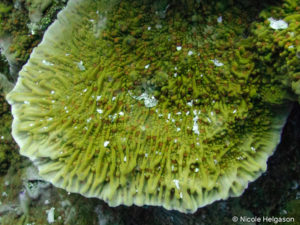
This lime-green Montipora has a beautiful color and intricate ridges, but the tiny orange polyps set it above and beyond the rest.
Montipora is one of the most abundant corals, with over 50 species in the Indo-Pacific. Montipora can be branching, encrusting, or form thin plates. Recognize this genus via the small corallites that are embedded in the surface of the coral. You’ll often find them between ridges, although they lack a distinct corallite wall. This coral comes in a variety of colors and the rarest have three or more colors in the same coral.
Cyphastrea

Cyphastrea corals have round corallites with separate walls. You can see spaces between the short, dome-shaped corallites.
Cyphastrea is a true encrusting coral, with only one species known to have a branching form. Recognize Cyphastrea via the round cone or tube-shaped corallites covering the surface of the colony. Importantly, notice that each corallite has its own walls with gaps or space between each new corallite. There are around 10 species of Cyphastrea.
Favia
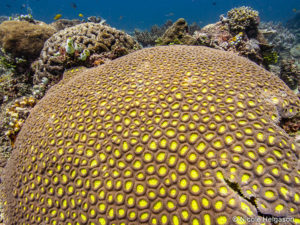
Favia corals have a separate corallite which looks like domes or tubes. You can usually see small gaps or spaces between them.
Favia are a diverse group of corals that can be encrusting especially when they are small, becoming massive domes or boulders as they grow. Common Favia colors are green, yellow and brown, but can also feature a mix of colors like orange, blue, and red. Identify a Favia coral by noting that it has distinct corallite walls.
Favites

These corals have shared walls and angular or polygonal-shaped corallites.
Favites is a lookalike coral that one can easily confuse with the Favia genus. With a little practice, you can tell these two apart by looking at the corallite. The Favites coral features fused corallite walls. This can be easier to see at night one the tissue is retracted and feeding tentacles are out. Favites coral walls are also more polygonal and unevenly shaped compared to the rounded, smooth Favia corallites.
Pachyseris

Pachyseris corals have a scribble-like appearance and can be encrusting, plating, or even branching.
Pachyseris has narrow ridges a few millimeters above the surface of the colony. The ridges can be long and narrow or short and contorted. There are five species of this coral, which can be plating, encrusting or branching. This coral lacks corallite structures and instead features septa-costea, which run perpendicular to the narrow ridges.
The post Introduction to Encrusting Corals of the Indo-Pacific appeared first on Scuba Diver Life.
from Scuba Diver Life https://ift.tt/2UlaEW9
Friday, March 29, 2019
Tips to Grow Prom Season Business

Prom Season begins in April and runs through the entire month of May. It’s also a great time to connect and introduce your salon to a new demographic - the teen market. Prom is an event many teen girls spend years dreaming about. Being a part of the memory, through readying the prom-goer, builds client loyalty and trust. Seize the opportunity to turn a prom appointment into a loyal client. It could be the beginning of a relationship that lasts long after prom night.
Teenage girls across the country are spending money on prom hair, makeup, brow shaping, facials, sunless tanning, manicures and pedicures. Whatever services you offer, be sure to build the prom season into your marketing calendar every year. Here are a few ways:
1) Offer Special Prom Promotion Packages.
Creating affordable packages geared toward teens generates new business, use the prom as a chance to connect with girls directly. Put together packages at 3 different price points and secure appointments with a 50% deposit (non-refundable).
2) Referrals Rock.
Talk up your prom services and promotions to current clients starting several weeks in advance. Word of mouth is one of the best ways to market your business. Try a friend referral offer for prom services. For example: Schedule prom services for yourself and a friend - get Lash Application for free.
3) Pre-Prom Prep Event.
Plan a pre-prom event to gather potential prom-goers to enjoy hair, makeup and nail demonstrations. The event can serve as a kick-off to your salon prom promotions. Start booking appointments on the spot.
4) Offer special splurges.
If there’s ever a time that a teen will splurge for a fancy hair clip, earrings or lip gloss, it’s for the prom. Even if you don’t typically stock these kinds of items, investing in some prom-appropriate beauty accessories and displaying attractively in key retail area/s boosts the bottom line every time.
5) Check the dates for your Proms.
Call your local high school/s and ask for the date of their prom. These dates will change every year, so in order to plan and staff accordingly make sure these dates are highlighted in your calendar.
6) Socialize.
Target prom-goers by crafting prom status updates. Keep the stream of content going for several months (April - May), share prom themed posts from beauty how-to’s, to prom hair inspiration, to prom planning tips. Facebook ads are a great place to start advertising special prom offers and services.
7) Prom Packages Email.
When the time comes to schedule prom beauty services make sure your salon is “top of mind” in mom’s minds. Send an e-mail campaign to promote your prom packages. For easy booking both online and at the front desk prom packages should have easy price points and memorable “package names” - for example Fling, Hot Date, and Memory Maker.
PROM PREP BEAUTY CHECK LIST - Use our Prom Prep checklist on salon social media channels to remind prom-goers to plan ahead and BOOK.
Date? Check. Dress? Check. Makeup? Hair?
Two months before prom: Book hair and makeup appointments
To ensure availability, schedule your salon appointment two months in advance.
Rip out magazine pages of make up and hair inspiration to show to your stylist.
Two weeks before prom: Teeth whitening
Book a teeth whitening session with a professional or start whitening your teeth using a product such as Crest White Strips.
Just over a week before prom: Get a facial
Often a facial can actually produce a small breakout as it rids skin of impurities, so schedule your facial a good week before the actual prom date. Give your skin time to recuperate.
One week before prom: Brow maintenance
Wait until one week before to shape or tweeze brows, otherwise you will start to get regrowth.
Two days before prom: Sunless tanning
This is a professionals only service. In order to get just the look you want do a trial run about two or three weeks before. In order to avoid fading or splotchiness schedule your spray tanning session for1 - 2 days before the actual prom date so that the finish is freshly applied and even.
The day before or day of prom: Get a manicure
To avoid chipping or fading, wait until the day before or the day of the prom to schedule your manicure appointment. Don’t forget, if your footwear is open toed a pedicure should be booked too. If you don't want to spend the money or if you get squeezed out of an appointment, do your own nails, but early in the day.
Get agency-quality marketing at a small business price. We offer stylish, professionally crafted prom promotions pre-designed by the beauty experts at BeautyMark Marketing. Reap the rewards of our beauty expertise and professionally crafted marketing plan with monthly promotions. We have developed a 12-month marketing plan, complete with salon marketing tools for each month of the calendar year. Visit here for more information.
from Beauty Business Blog https://ift.tt/2UgZUbC
Brothers Islands Reopens to Dive Boats
The Brothers Islands, a premier Egypt diving destination, have re-opened after a 3.5 month closure which followed four non-fatal shark-bite incidents involving oceanic whitetip sharks. Authorities hope the closure has returned the sharks to their normal behaviors and away from congregating around dive boats.
What caused the shark bites?
Authorities believe a number of factors caused the the sharks’ changing behavior:
- Deliberate and accidental feeding of sharks in the area
- Illegal fishing activities nearby
- A lack of understanding of how to interact safely with sharks
Changed rules
In a statement released by the Chamber of Diving and Water sports (CDWS) on March 15th, a new list of rules was issued for all liveaboard diving operators:
‘All dive operations CDWS members must abide the provisions mentioned in the Governor decree as follows:
- Boats may not stay overnight in the Brother Islands. The implementation of diving activities will be only from 6AM till 4PM, after which all boats should leave.
- The daily maximum capacity of boats on the Brothers Islands are 18; 12 boats for Big Brother and six for the Small Brother. This is only during the time mentioned in item No. 1.
- For safari boats to apply for a sailing permit to visit Brothers Islands, first they must get a coordination record with CDWS through this link. They must be able to present it to the coast-guard office of the Red Sea governorate.
- It is totally forbidden to dump any organic waste in the area of Brothers Islands. It should be dumped in open water by a sufficient distance for at least five nautical miles.
The new rules address shark-feeding at the islands. Although it is already illegal to dump organic waste here, authorities hope the new rules will further prevent boats from dumping waste like kitchen leftovers.
By removing food from the water, the sharks are more likely to maintain relaxed behaviors, rather than focusing on potential food sources.
The concerns around safe shark diving have also been tackled. CDWS required all liveaboard operators and dive guides to undergo a shark-awareness course to improve their understanding.
Further updates will be provided if and when they become available.
This article was written by divers and writers at LiveAboard.com
The post Brothers Islands Reopens to Dive Boats appeared first on Scuba Diver Life.
from Scuba Diver Life https://ift.tt/2CL2ix9
Condemnation as Maria Ressa arrested and charged again
from World News Publishing Focus by WAN-IFRA - World Association of Newspapers and News Publishers https://ift.tt/2CMPJBv
Thursday, March 28, 2019
Vibrant Aging and the Power of Connection
from The New Social Worker Online — the professional social work careers magazine https://ift.tt/2uzunmw
Wednesday, March 27, 2019
Take Care of You, So You Can Continue to Elevate Others
from The New Social Worker Online — the professional social work careers magazine https://ift.tt/2HXj8fS
Tuesday, March 26, 2019
The Value of Service in Emergency Room Social Work
from The New Social Worker Online — the professional social work careers magazine https://ift.tt/2UYydkI
Monday, March 25, 2019
Clinical Intersections: The Intake Process Is Sacred When Serving LGBTQ Folks - What Social Workers and Other Clinicians Need To Know
from The New Social Worker Online — the professional social work careers magazine https://ift.tt/2U9fEgG
LEAD 2019: Social Work Students Standing Together to Make Our Voices Heard
from The New Social Worker Online — the professional social work careers magazine https://ift.tt/2U9fA0q
Spring Cleaning = The Root of Retail Growth

Spring Equinox represents a time of renewal, sunshine, longer days, and revealing more skin, thus translating to some of the busiest months of the year for beauty businesses.
Along with Spring comes the traditional “spring cleaning” ritual. Let retail be the root of salon growth this season by freshening up your salon retail space. A well merchandised retail space that showcases your salon’s brands and product offerings will have the biggest impact on revenue this Spring.
I have found in my consultancy work that even the most beautiful salons and spas often have retail space that disappoints in both “experience” and revenue. Many salon owners invest thousands of dollars on product lines, but fail to invest in the basic elements to present brands and product offerings in an inviting manner that encourages sales.
Spring time is the perfect time to implement a formula for presenting beauty products beautifully and creating an ambience that makes clients want to spend - it all begins with Spring Cleaning.

Create a dedicated retail area.
A visually appealing retail space, when planned properly, can maximize sales by making products accessible and easy to browse.
Use great display shelving.
Avoid the average, opt for open spaced shelving presented in clean, straight lines. Model your retail space on luxury beauty retailers– optimize display and merchandising to encourage customers to pick it up, try it and buy it!
Create a focus table.
In the center of your retail space position a beautifully curated table of bestsellers, promotional or seasonal offers arranged on a focus table, ideally in direct view of clients as the enter and leave the salon.
Group brands together.
Brands make a better presentation visually when displayed together, on a shelf, looking fabulous and begging to be bought.
Signage is important.
Take the time to create shelf talkers and point of sale marketing materials, displayed alongside products highlighting USPs and usage instructions.
Put a price on it.
Pricing products makes them easier to sell, especially when it comes to impulse purchases. A simple price sticker on or retail price list displayed alongside the products assists with sales.
Keep it clean.
Often overlooked is the importance of cleanliness. Spring clean your retail space - keep your products spaced and faced, ensuring boxes or bottles are aligned and facing front and center. Testers should be replaced or replenished.
Avoid clutter.
When it comes to merchandising your shelving make products front and center and add your own branded flair.
Mix it up every season.
Change up your retail layout and focus each season. This encourages regular clients to take note of products they might previously have overlooked.

Bring Spring IN
Bring the spring into the salon. With some fresh ideas and creativity you can create a salon experience that guests will not find elsewhere. Theme everything to the "story" – color choices, merchandising support elements, point of purchase signs, seasonal merchandise offerings – should all further visually support the theme. A unique shopping atmosphere sells more retail and adds to the bottom line.
Spring Merchandising
Determine a Spring "look" for your beauty business and express it by choosing decorations and retail products that tell a story in your special branded way. This type of merchandising requires a little planning and a few "props" to add personality to salon displays.
Retail Displays
Create small vignette displays that are grouped by color or theme, the purpose is to show-off your "wares" in a fresh way each time a client visits, every 6 to 8 weeks. Mix retail with merchandising support elements - these are the little details such as butterflies, nests, eggs, bird cages, gardening tools, vintage books, baskets, or trinkets that make your displays special.
Fresh Flowers
Fresh flowers mixed into displays add instant zest for such a little cost. Fresh small bouquets in varying mini vases filled with tree branch blossoms, violets, bulbs, or flowers of any color add spring to any retail display.
Shelf Talkers
Tell your story clearly with themed point of sale signs or shelf talkers mixed into retail displays. Point of sale signs clearly state prices, products, packages, or specials you wish to highlight which both informs and encourages purchase.
Spring Merchandise
Don’t limit your Spring retail your salon normally stocks. Load up your retail space with spring-themed merchandise such as floral headbands, clips, sunglasses, spring trend makeup, nail lacquer, and jewelry.
Spring-Themed Window Displays
Flowers and everything green are traditional symbols of Spring. Pick a theme, go floral, go green.
Spring Themed Selfie Station
What is a Selfie Station you ask? It's a cool staged place or space in your salon specifically designated for clients to take selfies – just make sure you include your salon logo and hashtag. Add a Spring Selfie Station in your salon to play up the season. A green leaf backdrop with florals, hanging paper flowers, the possibilities are endless.
Easter Merchandising
The Easter holiday is a key calendar event, yet it is often overlooked. The timing of Easter sits in line with spring promotions, so play it up with pastel shades, bunnies, eggs, baskets, and all the sweet items that makes Easter time such a treat.
Need a Promotion?
Need a Spring promotion and haven't planned it yet? Let BeautyMark help maximize your Spring Season returns. Check out our pre-made email campaigns, social media graphic posts and website banners. Don't miss out on another revenue-generating opportunity.
Visit here to learn more about our pre-made promotions.

from Beauty Business Blog https://ift.tt/2FyP5bA
Sunday, March 24, 2019
The Aura of Social Work
from The New Social Worker Online — the professional social work careers magazine https://ift.tt/2FxyplZ
Senators Stabenow and Barrasso Re-Introduce Improving Access to Mental Health Act
from The New Social Worker Online — the professional social work careers magazine https://ift.tt/2Olq8UX
Saturday, March 23, 2019
Service Before Self
from The New Social Worker Online — the professional social work careers magazine https://ift.tt/2Yl2jRx
Marine Species: Mandarinfish
With its vibrant, stained-glass coloration, divers may think it would be easy to spot mandarinfish on a reef. But don’t be fooled — these tiny jewel-toned fish are very shy and emerge only at dusk, so spotting them is a real treat.
What are mandarinfish?
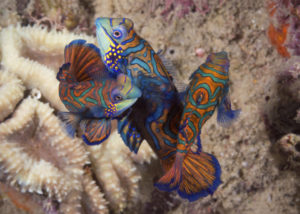
Part of the dragonet family, mandarinfish are named for their vibrant colors, similar to an imperial Chinese officer (Mandarin). They are quite small, up to only 2.4 inches (6 cm) in size and feed mainly on small worms, crustaceans, and other small invertebrates. Interestingly, these are one of the few fish that do not have scales. Instead, a mucus-coated skin protects them from diseases and predators.
Where are they?
You can find mandarinfish in the Western Pacific Ocean from Malaysia to Australia. They usually live on shallow reefs or among coral rubble in protected waters. They seek out habitat with lots of hiding places.
Why are they so hard to spot?
Not only their small size makes it difficult for divers to spot mandarinfish, but also their habits: they are quite shy and are bottom dwellers, so they spend a lot of time dissimulated in the reefs. Their mating ritual is quite specific and usually happens around sunset. A few females will gather in a specific spot on the reef and the males will visit and court the females. Once the male is successful and has impressed a mate, the female will come and rest on his pelvic fin.
The pair will rise together, belly-to-belly, a few feet above the reef, where they will release sperm and a cloud of eggs before parting. The fertilized eggs will then drift in the current and take about 24 hours to hatch. This ritual is quite special to watch, so in places where mandarinfish commonly live there are often sunset dives specifically to see them.
How can you increase your chances of spotting one?
The Coral Triangle is the best place to spot a mandarinfish. Local dive shops will usually know good spots to find them, and as mentioned, dusk is the best time for a dive.
The post Marine Species: Mandarinfish appeared first on Scuba Diver Life.
from Scuba Diver Life https://ift.tt/2Fy3d69
Friday, March 22, 2019
8 tips to guide introduction of robot journalism
from World News Publishing Focus by WAN-IFRA - World Association of Newspapers and News Publishers https://ift.tt/2TRx0PY
8 tips to guide introduction of robot journalism
from World News Publishing Focus by WAN-IFRA - World Association of Newspapers and News Publishers https://ift.tt/2WaBzBo
Product dev teams: where the magic happens
from World News Publishing Focus by WAN-IFRA - World Association of Newspapers and News Publishers https://ift.tt/2uv3tMV
Thursday, March 21, 2019
A Label is Not the Whole Story
from The New Social Worker Online — the professional social work careers magazine https://ift.tt/2CwxIY2
Coral Disease Outbreak Affects Florida and Caribbean
Parts of Florida and the Caribbean are currently suffering from a historic, ecosystem-altering coral disease outbreak. The situation is eliciting an unprecedented response from scientists, resource managers and the public in Florida. Here, divers have the opportunity to contribute to an extraordinary effort to research, remediate and restore damaged coral.
Stony-coral tissue loss disease

Recent death of the brain coral in the foreground indicates the coral next to it will likely suffer the same fate from stony-coral tissue loss disease. Credit: Greg McFall/NOAA
Stony-coral tissue loss disease first appeared in a chronically-stressed region near Miami in 2014. Soon after, it rapidly spread to the upper reaches of the Florida Reef Tract and south into the protected waters of Florida Keys National Marine Sanctuary. By early 2019, the highly lethal disease reached the outer reefs off Key West with reports of a similar outbreak in Mexico, Jamaica, St. Maarten, and the U.S. Virgin Islands.
Unlike white plague and other common coral disease, stony-coral tissue loss disease affects 22 species — half the hard-coral species in Florida. This presents a serious setback for reefs already suffering from climate change, ocean acidification, pollution, fishing pressures, and other increasing human interaction.
Response to the outbreak
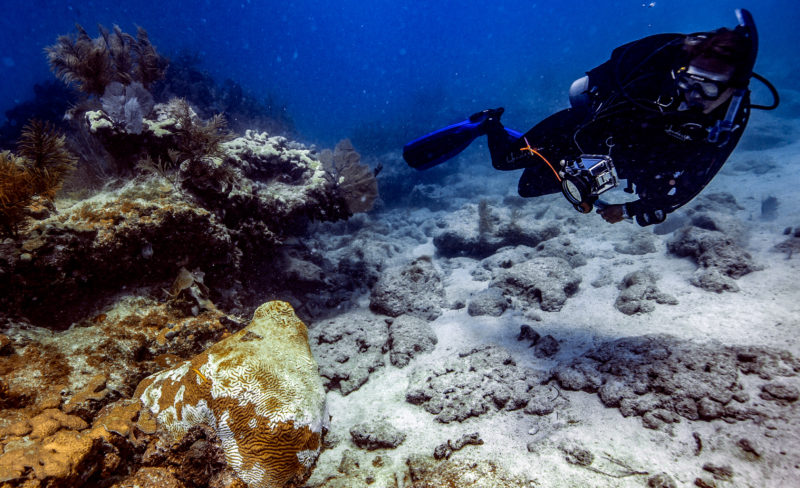
Science divers monitor progression of stony coral tissue loss disease in Florida Keys National Marine Sanctuary. Credit: Nick Zachar/NOAA
The aggressive response to this ecosystem-altering event involves an unparalleled collaboration of government agencies, academic institutions, and nonprofit organizations. All are working together to document the outbreak, identify likely causes, understand contributing environmental factors, and develop innovative treatments to slow or stop the disease. In the meantime, they’re attempting to rescue healthy, genetically-diverse corals for future restoration.
“Nowhere in the world have there been this many organizations coming together focused on a coral disease event,” says Dr. Andrew Bruckner, research coordinator at Florida Keys National Marine Sanctuary. “That tells you that there is intense concern about the ecological and economic impacts that stony coral tissue loss disease could have here in Florida and beyond.”
What’s at stake
Southeast Florida’s coral-reef ecosystem supports more than 71,000 jobs and $6.4 billion in sales and income annually. In the Florida Keys, approximately 60 percent of all jobs are tied to the marine ecosystem including diving, boating, recreational and commercial fishing, and tourism. The continental United States’ only coral barrier reef also presents a natural buffer, lessening the strength of waves and protecting human life and property.
There is still much to learn about stony-coral tissue loss disease, and investigation is ongoing. Researchers believe the pathogen is a bacteria transmitted through water circulation and touch. Until they are able to determine the pathogen, it is difficult to confirm that a similar outbreak in the Caribbean and Mexico is the same disease afflicting Florida reefs.
What can divers do?
Divers are urged to use proper diving techniques. Crucially, they must decontaminate dive gear between dives as well as before and after each dive excursion, especially when traveling between countries or between infected and uninfected sites.
Decontaminating dive gear
First, remove debris and sediment following each dive. With a bleach solution, sanitize non-sensitive gear that contacts corals. Wash other gear in fresh water and use antibacterial soap. Use quaternary ammonium solutions to decontaminate dive gear after you return to shore.
For BCD internal bladders, pour approximately ½-liter of disinfecting solution into the mouthpiece of the exhaust hose while depressing the exhaust button. Inflate the BC, and gently rotate in all directions. Allow it to sit for 10 minutes and flush twice with fresh water. Soak regulators, computers, gauges, underwater cameras and other sensitive equipment for 20 minutes in a solution of warm water and antibacterial dish soap. Rinse in fresh water and air dry. Additionally, or alternately, thoroughly wipe with isopropyl alcohol.
It is important to always properly dispose of disinfectant solutions and rinse water in a sink, tub or shower. Never pour into the ocean or a storm drain.
Coral condition reporting
Divers in Florida can help report coral conditions to the Southeast Florida Action Network (SEAFAN), the Florida Department of Environmental Protection’s public reporting tool. Observations greatly enhance scientific knowledge of disease presence while also helping to identify key areas for targeted research and interventions. Reports of healthy corals help identify particularly valuable and resilient reefs. Identifying tags are placed on some treated corals on the Florida Reef Tract, encouraging divers to upload photos.
Florida Sea Grant agents in South Florida are training recreational divers to properly identify stony-coral tissue loss disease and conduct surveys to monitor disease progression and coral recovery. There is an optional dive after each free training session.
Relieving Stress
In order for restoration to be successful, we must relieve stress on the marine ecosystem. We must improve water quality, reduce runoff and keep trash contained. Use reef-friendly sunscreen and wear sun-protection clothing to reduce the need for sunscreen. Practice safe boating, including using mooring buoys to avoid anchor damage. And if you must eat fish, opt for sustainable seafood to address the issue of overfishing.
Expand Your Education
Coral reefs cover less than one percent of the Earth’s surface. However, they are home to 25 percent of all marine fish species. Coral diseases are increasing in frequency, intensity, and geographic range. A plethora of information about corals exists online from NOAA and other valid sources. For specifics on stony-coral tissue loss disease, including ways that you can help, visit the Florida Keys National Marine Sanctuary’s website.
By guest author Gena Parsons, National Marine Sanctuary Foundation Communications and Outreach Manager
The post Coral Disease Outbreak Affects Florida and Caribbean appeared first on Scuba Diver Life.
from Scuba Diver Life https://ift.tt/2U80bh3
Wednesday, March 20, 2019
“Elevate” Others: Sharing One’s Pride in the Profession of Social Work
from The New Social Worker Online — the professional social work careers magazine https://ift.tt/2HLNUIy
Tuesday, March 19, 2019
Will You Come Back Tomorrow? The Root of Service Is Passion and Love
from The New Social Worker Online — the professional social work careers magazine https://ift.tt/2CsSRT3
Loriann Jewelry’s powerful new collections.
Like all artists, a jewelry designers’ aesthetic evolves over time, and there’s a unique beauty in the progression of an artist’s designs. Witnessing that growth as part of a larger whole adds context and additional meaning to every piece in the body of work.
Loriann Friedman of Loriann Jewelry is someone I clicked with the moment we met. Her designs are a blend of passion, artistic vision, and thoughtfulness that results in compelling jewels that elicit deep feelings of connection in a wide range of jewelry lovers.
Today it is my great honor to become the very first blogger to feature all FOUR of Loriann Jewelry‘s gorgeous new collections!
This quartet of interconnected but individual collections is the result of many months of soul searching and growth on the designer’s part, the distilled and powerful artistic result of a period of time that brought both the birth of designer Lori’s first grandchild and the loss of her beloved father.
Continue reading Loriann Jewelry’s powerful new collections. at Diamonds in the Library.
from Diamonds in the Library https://ift.tt/2Htyvx9
Monday, March 18, 2019
World Social Work Day, the Importance of Human Relationships and Self-Care, and the Human-ness of Social Workers
from The New Social Worker Online — the professional social work careers magazine https://ift.tt/2CqHD17
I Never Knew, 10 Years Later
from The New Social Worker Online — the professional social work careers magazine https://ift.tt/2UH4w7O
How to Snap Pro-Quality Smartphone Images for Social Media

Taking high quality hair and beauty images is an absolute must in the beauty industry engagement craving, pin-worthy world. Luckily, you don’t need a top notch camera, your smartphone will do the trick just fine. Want to get really fancy? Fire up your smartphone and tap your way to professional, branded photos with the tips below:
1. Natural and Diva Ring Lighting
Take advantage of the your salon’s sources of natural light, such as a window, then add in a Diva Ring Light. This is the ultimate tool to take salon images from so-so to so-pro.
The professional-quality fluorescent Diva Ring Light provides soft, nearly shadowless illumination. The secret is in how the light is shaped. It is able to cast a soft dome of light on your model complementing the hair color, makeup and skin making this light ideal for portrait style shots. The illuminating qualities helps to eliminate skin imperfections & makes your model’s face appear to have a fresh clean look. It also comes equipped with a dimming and diffusion feature that helps control your light source. For more information check out their website here https://www.divaringlight.com/
Tip: When shooting indoors, shoot near a natural light source, window, if possible.
Tip: Take the picture with your back to natural light source.
Tip: Forget the flash - flash creates shadows, distorts color and casts an unflattering yellow light over your model or product.

2. Background and Style
Background matters. Transform ordinary pictures into standout shots with the use of a simple background. The model is the focal point, but you want to select a nice background too. Select a clean painted wall for the model to stand in front of, or go outside and take the shot.
Background ideas:
- Find a colored wall to shoot in front of (we love white or gray)
If going outside look for a clear, colorful, or bright background:
- Find a brick, stone, tile, or rock wall to shoot in front of
- A blooming wall of flowers is the holy grail of backdrops
- Shoot hair or beauty products placed on wood, marble slabs, colored tile, whatever fits your brand
3. Take a Variety of Shots
Practice makes perfect, and variety helps. If you take three shots to five shots of the same hair model you’re bound to get “the shot” that makes it to your social media page. Try camera angles from the side, the back and at an angle. Choose the best one of the series.
4. Resolution
Smartphone cameras are improving, but the second you start zooming, you lose picture quality. Don’t zoom as it will turn your image grainy or blurry or pixelated. It sounds very simple, but instead of zooming move closer.
5. Framing and Composition
Before taking your photo “set up” both the frame and composition of the shot. This is easy utilizing the grid on your smartphone.
To switch the grid on:
iPhone: Go to "Settings," choose "Photos & Camera," and switch "Grid" on.
Samsung Galaxy: Launch the camera app, go to "Settings," scroll down and switch the "grid lines" option to “on."
To produce well-balanced photos we recommend applying the rule of thirds. The grid will display 9 boxes on top of your proposed photo. The center 4 intersections lines and center box on your grid are guides for placing focal points in your photo.
The theory is that if you place points of interest in the intersections or along the lines that your photo becomes more balanced and will enable a viewer of the image to interact with it more naturally.
6. Editing Tools
Once you’ve chosen your "it" shot, turn to a mobile photo-editing app or tool to crop, straighten, or enhance your photos with filters. Add salon logo to your image and voila! You are ready to post. Watch out world!

from Beauty Business Blog https://ift.tt/2Csmm7p
How BloombergQuint monetised WhatsApp through branded content
from World News Publishing Focus by WAN-IFRA - World Association of Newspapers and News Publishers https://ift.tt/2Cs2ocO
Sunday, March 17, 2019
Why Regulation Elevates the Social Work Profession
from The New Social Worker Online — the professional social work careers magazine https://ift.tt/2JgKYFY
The Science of a Scuba-Related Panic Episode
Diving is fun, adventurous, often exhilarating and often meditative. But there’s a darker side of diving as well, which we often gloss over with phrases like “in the unlikely event,” and “Stop. Breathe. Think. Act.” During my diving career I have experienced everything from a slight anxiety to full-on panic episodes. As an instructor, I have seen students and fun divers in similar situations. While some people can bring themselves back from the edge, others escalate to a full panic experience. I remember some of my very first dives, when I was right on the edge of panic but unable to speak out about it because of how I thought others would perceive me. So let’s talk a little bit about a scuba-related panic episode and what you can do to bring yourself back from the brink.
In 2003, the Undersea Journal published research by David and Lynn Colvard on panic among recreational scuba divers. The study states that researchers think that a panicked response to stress plays a large role in dive fatalities. Alfred Bove, author of Medical Examination of Sport Scuba Divers, echoes this sentiment: “panic, or ineffective behavior in the emergency situation when fear is present, is the single biggest killer of sport divers.” Unfortunately, we cannot know this for sure, but what do we know about panic and diving?
What does the research say?
The Recreational Scuba Training Council’s (RSTC) 1998 guidelines for the recreational scuba diver’s physical examination listed ‘a history of panic disorder’ as a no-go zone for divers. This means that individuals with a history of panic disorder were deemed medically unfit to dive. In 2001, the guidelines changed to include a ‘history of untreated panic disorder’ as a high-risk condition for diving, but also acknowledged that with treatment, such conditions pose a lower risk to diving activities.
What causes panic attacks?
First, we need to define a panic attack. For their research, the Colvards defined it as “an intense fear of losing control or dying.” They linked this to the definition of a panic attack found in the 5th edition of the Diagnostic and Statistical Manual (DSM) of Mental Disorders, which defines an attack as “a discrete period of intense fear or discomfort that is accompanied by at least four of 13 somatic or cognitive symptoms…often accompanied by a sense of imminent danger or impending doom and an urge to escape…or desire to flee from wherever the attack is occurring.”
For divers this could turn into an uncontrolled ascent or other kind of flight response. The Colvards found that 15 percent of divers who experience their first panic while diving engaged in a rapid or uncontrolled ascent. While this number seems relatively low, it is based on a survey of current divers. To date there is no information on how many divers stopped diving due to experiencing panic. We also cannot establish how many diving fatalities panic has caused. Investigators often label these cases as drowning deaths, with little information on the events leading up to the incident.
Who is at risk?
Women, and especially women who have a history of panic attacks, tend to experience more panic attacks than men. On the other hand, the men who participated in the Colvards’ research viewed their first panic during a dive as life-threatening. They also found that women tend to accept help more often than men and attribute this to the possibility that in many cultures men are conditioned to be self-reliant.
People who have a history of panic attacks above water are about twice as likely to panic while diving as those who have never experienced a panic attack before. They are also more likely to have more than one panic experience while diving.
Triggers are unique to every individual. We do know that it is not dependent on when you last dived or on your certification level.
How can you address scuba-related panic?
Happily, the Colvards found that most divers who had experienced a panic episode while diving remembered and used their training on how to deal with the situation. They also found that most divers who experienced a panic situation while diving went for additional training afterwards.
Panic happens when an individual does not have any solutions for a serious problem. The quality of training will help provide divers the skills they need in these situations. Repeating and practicing skills to become familiar with them can change the way a diver reacts in a panic situation as well. Furthermore, by continuing their education, divers increase their available skills, which they can rely on if they do feel panicky.
How to recognize a panic attack
A panic is a distinct episode of fear and discomfort with four or more of the following symptoms present. They develop quickly and peak in about 10 minutes:
- palpitations, pounding heart, or accelerated heart rate
- sweating
- trembling or shaking
- sensations of shortness of breath or smothering
- feeling of choking
- chest pain or discomfort
- nausea or abdominal distress
- feeling dizzy, unsteady, lightheaded or faint
- derealization (feelings of unreality) or depersonalization (being detached from oneself)
- fear of losing control or going crazy
- fear of dying
- paresthesias (numbness or tingling sensations)
- chills or hot flashes
The post The Science of a Scuba-Related Panic Episode appeared first on Scuba Diver Life.
from Scuba Diver Life https://ift.tt/2UH3bh8
Saturday, March 16, 2019
A Basketful of Good Intentions
from The New Social Worker Online — the professional social work careers magazine https://ift.tt/2HDGd70
Friday, March 15, 2019
Marine Species: Black Coral
Despite its name, black coral is rarely black. In fact, this deep-dwelling coral species is most often either white, red, green, yellow or brown; its name refers to the skeleton’s color. Part of the order Anriparharia, there are more than 280 species of black coral worldwide. While abundant at depth, residing between 1,000 and 10,000 feet (300 and 3000 m), recreational divers can nonetheless see a variety of species in shallower water. Harvested for decades between the middle and end of the 20th century, black coral was highly sought after for lucrative jewelry pieces. This industry has unfortunately devastated many shallow black-coral gardens, especially in Hawaii where the coral was once bountiful.
What makes black coral special?
Extremely different from other well-known coral families, black coral is unique due to its skeletal formation. Some species are wispy, resembling coils of DNA. Others look like trees and others are only single stalks. Protein and chitin make up all black coral, and it does not need light to grow, as other corals do. Consequently, this species thrives at depth. In fact, the chitin allows the thinner branches to be flexible while the stem is thicker and provides structural support like a tree trunk. Many species can grow larger than 12 feet (3 m). Others grow to no more than 1.2 inches (3 cm). Although the coral has thousands of polyps, this living tissue is minute. Microscopic thorns protrude from each skeletal branch, thus the common nickname ‘thorn coral.’
Where can you find it?
While black coral is somewhat difficult to study in great detail due to its depth, scientists believe that it flourishes in tropical and subtropical regions, where it feeds on zooplankton blooms. However some species grow even in the frigid Arctic and Antarctic waters. This coral tends to have very few predators except for some gastropods such as sea snails and turtles. Consequently, scientists think one species, ‘Leiopathes glaberrima‘ has lived to 4,265 years of age, making it one of the oldest organisms on earth.
Divers can observe black coral easily on the Baros Atoll in the Maldives, on deeper sites in the Canary Islands, in New Zealand’s Milford Sound, and especially in Hawaii, where black coral is so famous that it is the official state gem of the islands.
The post Marine Species: Black Coral appeared first on Scuba Diver Life.
from Scuba Diver Life https://ift.tt/2T7P2Ib
New RISJ research gauges impact of Panama Papers three years on
from World News Publishing Focus by WAN-IFRA - World Association of Newspapers and News Publishers https://ift.tt/2HGjMyf
Thursday, March 14, 2019
Elevating Competence in Social Work
from The New Social Worker Online — the professional social work careers magazine https://ift.tt/2W2tO0b
Wednesday, March 13, 2019
Social Work Is My Dream, But We Must Work Every Day To Make Our Dreams Become Reality
from The New Social Worker Online — the professional social work careers magazine https://ift.tt/2ChSTNu
Easy Ways to Take Part in Ocean Conservation
Ocean conservation is more important now than ever — keeping our oceans clean and saving the reefs is top priority. Are you doing your part to keep them clean for generations to come? Read on for a few tips to make sure you’re doing your part to protect what you love.
Take part in ocean cleanups
Taking part in local beach clean-up events helps keep our oceans clean. Stay up-to-date on when these types of events happen near you. Or, simply make it your personal mission to clean up the beach whenever you’re spending time on the sand and in the water. Be sure to bring along a biodegradable or reusable bag for trash collecting.
Use safe body care products
Using ocean-friendly products is a must. Everything you put on your body will wash off into the oceans, affecting all the marine life that lives there. Did you know that just one drop of chemical sunscreen in six Olympic-sized swimming pools can kill coral? It’s so important to know what you are putting on your body and introducing into the environment — what you assume is safe for you may not be safe for marine-life.
To help keep from harming marine life, make the switch to mineral sunscreen.
If you’re overwhelmed by the options that line the store shelves, don’t worry — we’ve got you. Check out the top-notch mineral sunscreen from Stream2Sea. All of their products are proven to be reef-safe and ocean-friendly — all the way down to their recyclable bio-packaging. The sunscreen tubes are made from sugarcane resin and their bulk sunscreens come in containers made from recycled milk jugs. They even have an assortment of soothing lip balms, hair-care products and after-sun products.
Take a stand against ghost-net pollution
Abandoned fishing nets make up a huge percentage of the plastic pollution in the ocean. You may not be able to remove these “ghost” fishing nets from the waters yourself, but you can buy products that use the recycled nets to help create a market for recovered nets.
Various products are committed to upcycling this harmful pollutant, including Stream2Sea’s line of Eco Apparel. Take an extra step to seek some shade and support pollution cleanup by wearing an eco-conscious rash guard made from recycled ghost nets.
Call to action
Your personal choices matter — from the products you use on your skin and hair to choosing to help clean up a messy beach. Knowledge is power, so be sure to check out Stream2Sea’s Education Center. Here, you can see free education modules and learn more about the science and importance of protecting the oceans.
Once you’ve fortified your reef-safe knowledge, spread the word and advocate for the oceans and reefs. Stay informed on the major steps that are happening toward sunscreen bans. So far, Palau, Hawaii, Bonaire, Aruba, and Key West have all banned some harmful chemicals contained in sunscreen.
Protect what you love by making eco-conscious and informed decisions about what you put on your body, sharing your knowledge and keeping our beaches and oceans clean and generations of divers and ocean-lovers will have you to thank.
Guest post by Stream2Sea
The post Easy Ways to Take Part in Ocean Conservation appeared first on Scuba Diver Life.
from Scuba Diver Life https://ift.tt/2JcES9y
Top Types of Liveaboards
Divers have long known that liveaboard diving is one of the best ways to reach remote dive sites and unique destinations, plus conduct the most dives per day. As liveaboard diving continues to grow in popularity, a huge variety of vessels and onboard facilities have become available, with something for all budgets. You might choose a boat based on its appearance or destination, but there are more advantages to the different vessel types than meets the eye. Let’s take a closer look at what you can expect from the top types of liveaboards available today.
Phinisi

The Indonesian Damai phinisi
What is it?
The phinisi — or pinisi — is a traditional Indonesian sailing vessel with a rich history. Phinisi boats are part of Indonesia’s ancient shipbuilding tradition and are usually hand-hewn from exotic and rare woods. They were originally used to carry spices and textiles along the ancient spice route. Modern phinisis have been repurposed for cruising and diving. UNESCO recognizes the importance of phinisis boats and has listed south Sulawesi’s hand-crafted sailing boats as “Intangible Cultural Heritage.”
What are the advantages of phinisis?
The hull shape ensures smooth and easy sailing, allowing guests to relax comfortably and mitigate motion sickness. While these boats have good sailing capabilities, they also have powerful engines to minimize travel time to each safari destination, ensuring guests can make the most of island-hopping and their dive time.
What can you expect from a phinisi liveaboard?
Phinisi boats are a beautiful style of liveaboard and you can expect rich wood interiors, traditional designs and cozy rooms. They sail some of Indonesia’s best waters and are a good choice for romantic liveaboard safaris or relaxing under the sails as you cruise from island to island. There are a variety of phinisi liveaboards to choose from, with safaris ranging from three to more than 10 nights.
Steel hull

The Nautilus Explorer is a well-known steel-hull liveaboard
What is it?
Steel-hull boats are, as the name suggests, made from steel. This is the type of boat most people associate with liveaboard diving. These strong and stable boats visit a variety of top dive destinations around the world and are a popular choice with well-known liveaboard fleets.
What are the advantages of steel-hull boats?
These modern boats are known for their strength and are built to excellent safety standards. They have a variety of safety features, such as compartmentalized hulls, so any unexpected leaks at sea can be easily contained. They are also very stable in choppy waters, with the steel hull and boat design ensuring a comfortable ride even on high seas. They are perfect for reaching remote dive destinations.
What can you expect from a steel-hull liveaboard?
Being modern, you can expect steel-hull boats to have some of the best facilities, spacious rooms and everything a diver could need onboard. They can be high-end safaris, as they are expensive to build, but there are both luxury and budget options available. These sturdy boats reach can remote dive sites easily, allowing divers to get in the water with big pelagics at destinations such as the Socorro Islands and Guadalupe, Mexico — without compromising on comfort at sea.
The Nautilus fleet offers a great example of the diverse facilities available, including onboard open-air cinemas and luxury staterooms. Steel-hull boats also cruise Egypt, French Polynesia, Micronesia and many more destinations.
Sailing yacht
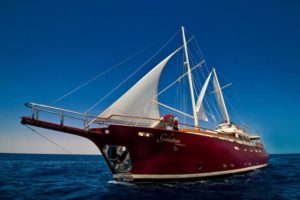
The Galatea in Seychelles
What is it?
Sailing yachts are easy to identify, with sleek designs and billowing sails. While they might not be the first option that comes to mind when you picture liveaboard diving, there are some great reasons to try diving from a sailing yacht.
What are the advantages of sailing yachts?
Sailing yachts are perfect for combining scuba diving, sailing and utter relaxation on the ocean. These boats are spacious and have classy interiors, with plenty of luxurious and modern facilities to choose from. Sailing yachts are ideal for families and groups with non-divers, as they usually combine diving with watersports activities and island hopping. One of the best advantages of diving from a yacht is the chance to slow down, unwind and enjoy a slower pace of life at sea.
What can you expect from a sailing yacht liveaboard?
If you choose a sailing yacht liveaboard you can expect a relaxed vacation, sailing and diving around islands and exploring white-sand beaches. Destinations include Indonesia, Micronesia, the Maldives and Thailand.
The Seychelles is a popular destination for sailing liveaboards and there are plenty of dive sites to choose from while exploring some of the 100 islands on offer.
Catamaran
What is it?
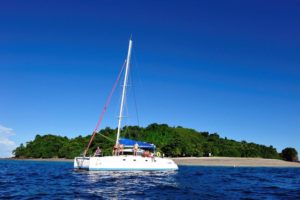
A Madagascar catamaran
Catamarans have two parallel hulls and can function as both motor and sailing yachts. Catamarans have some unique design features that make them ideal for divers who suffer from motion sickness and want to ensure they are comfortable at anchor.
What are the advantages of catamarans?
Catamarans have a shallow draft, allowing them to cruise and anchor in shallow places that few other boats can reach. This design feature allows catamarans to visit quieter dive sites, avoid swells and ensure guests have a good night’s sleep at anchor. They also have fantastic stability and can alleviate seasickness more than monohulled boats can. Catamarans are quiet and can cruise the seas at speed, allowing divers to reach a variety of dive sites while also enjoying the experience of being aboard a sailing boat.
What can you expect from a catamaran liveaboard?
If you join a catamaran trip you can expect an intimate dive safari, as they often cater for smaller groups. Being part of a small dive group allows more flexibility with the dive itinerary and ensures a more personalized service. You can also expect easily-accessible 360-degree views of the ocean from the boat and fun extras, such as onboard trampolines.
Catamaran liveaboards cruise a variety of stunning destinations, including French Polynesia, Madagascar and Western Australia. Other top catamaran destinations include the Bahamas, the Philippines and Myanmar (Burma).
Expedition ship
What is it?
Expedition ships are typically larger ships, often used for both diving and cruising safaris. They are built to withstand all sea conditions and visit some of the harshest destinations on the planet.
What are the advantages of expedition ships?
Expedition ships offer adventurous divers the chance to visit and explore some of the most pristine and untouched environments on earth. These ships can cope easily with icy seas, challenging swells and long crossings, all without compromising guest comfort and entertainment. Expeditions ships are ideal for ice diving, wildlife watching, and nature photography.
What can you expect from an expedition ship liveaboard?
You can expect these ships to accommodate numerous passengers and have plenty of social areas, extensive walking space on deck, and a huge variety of onboard facilities. Expedition ships often have a rich history of scientific research to discover and combine diving, cruising, wildlife watching and activities such as hiking, kayaking remote shorelines, and getting up-close to wildlife. They are ideal for exploring and diving the Arctic and Antarctica.
Divers and writers at LiveAboard contributed this article.
The post Top Types of Liveaboards appeared first on Scuba Diver Life.
from Scuba Diver Life https://ift.tt/2TOeZkw






